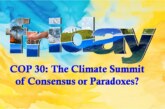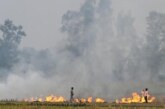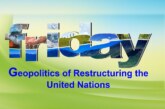
Dr. Arvind Kumar*
Climate change makes extreme heat stretches more common, longer, and more severe, scientists warn of impacts that could put more than a billion lives at risk. Since last summer in 2023 which was the warmest year on record globally we never thought the national capital, Delhi will break all the records by touching a scorching temperature of 52.3 degrees Celsius, the highest recorded temperature in India everearlier than usual for the third summer in a row, This scorching summer also brings with it water scarcity and crisis. Agriculture is the largest consumer of the world’s freshwater resources, and more than one-quarter of the energy used globally is expended on food production and supply. The vast majority of energy generation is water intensive, such as its use in coal-fired power plants and in nuclear reactors, and in bio-fuel crop production. Pressure on the nexus is being driven by a rising global population, rapid urbanization, changing diets and economic growth. There is a significant global move away from a mainly starch-based diet to an increasing demand for more water-intensive meat and dairy as incomes grow in many countries. The water scarcity problem is not only a result of quantitative or qualitative shortage but also a consequence of inefficient use and poor water management.
Is it enough to plant saplings in monsoon or develop some slogans for water conservation?
Water touches every aspect of development and each sector is connected with water. It is not just a sector but a connector an economic indicator and a must for social development, vital to maintain health, grow food, generate energy, manage the environment, and create jobs. Approximately 2 billion people around the world do not have safely managed drinking water services, 3.6 billion people do not have safely managed sanitation services, and 2.3 billion lack basic handwashing facilities. Gaps in access to water supply and sanitation, growing populations, more water-intensive patterns of growth, increasing rainfall variability, and pollution are combining in many places to make water one of the greatest risks to economic progress, poverty eradication and sustainable development. When the situation worsens the government starts imposing fines like the Delhi govt has directed Delhi Jal Board to impose a fine on water wastage.
Why do we only rise when the damage has been done? When will India prepare for a water stress situation?The 2030 Water Resources Group has calculated that India’s water demand will outstrip supply by almost 50 per cent by the year 2030. A significant challenge; therefore, to increase conservation of water across operations and geographies has become imminent. India’s major dependence on groundwater has resulted in over-extraction which is lowering the water table and adversely impacting drinking water supply. India is the world’s largest user of groundwater that extracts more than any other country in the world and accounts for nearly 25 per cent of the world’s extracted groundwater.
Water, a casualty of development?
Today, even a small piece of land in urban areas has a high economic value. These urban water bodies are not only acknowledged for their ecosystem services, but for their real estate value was well.India is urbanising at a phenomenal rate currently, 35% of the Indian population resides in urban areas. This is projected to reach 43.2% by 2035. Surface water bodies such as ponds, tanks, lakes, reservoirs, percolation tanks, etc., play a significant role in mitigating both current and future water-stress incidents. They serve as storage reservoirs that can be accessed during water-scarce periods, to recharge groundwater and facilitate flood control by absorbing storm water run-off.The overall idea is very much aligned with the Prime Minister’ Modi’s ‘Mission Amrit Sarovar’ for preservation and restoration of wetlands and sustainable use of their resources by maintaining their ecosystem services. However, is there relevant accurate data on the number of water bodies created under this mission? Are these still functioning or dried up? As former member of the National wetlands Committee of the ministry of Environment forests and climate change while drafting the guidelines for the Wetlands Conservation and Management Rules, 2017 pushed for the participation of local communities in governing and monitoring wetlands. With the advent of these guidelines around 757,000 wetlands with a total wetland area of 15.3 million ha, accounting for nearly 4.7% of the total geographical area of the country were identified. At UNCCD COP14 India announced ambitious targets of restoring twenty-six million hectares of degraded land between now and 2030. What is the latest data on this claim?
The challenge is that we are programmed to consider acute stresses (heat, water, land degradation or extreme weather) as temporary, to be handled often as disaster relief. We must move from panic reactions when disaster strikes to understand and respond to the chronic nature of risks we face. Moreover, climate action cannot be left to a few sectors or businesses. Nor can environmental sustainability be reduced to sapling plantation drives over a few days. Similarly, water conservation slogan is not enough to save water. The solution to sustainable drinking water does not wholly depend on the drinking water supply itself, but on other uses like agriculture, especially monoculture cropping of water intensive crops.Rice and wheat, two of India’s most important food crops, are also the most water-intensive. Producing a kilogram of rice requires an average of 2,800 litres of water, while a kilogram of wheat requires 1,654 litres.
The ambitious Jal Jivan Mission of India was a boon for water-starved districts and villages with dramatic increase in the number of water taps connections.However, a visit to some of the villages here suggests that a household certified as “connected” in JJM parlance does not always mean one with an actual water supply.According to the scheme’s definitions, an FHTC household is one where at least 55 litres of potable water per person a day is made available to every household.Some of these villages are still reliant on groundwater from handpumps for domestic drinking purposes.However, given the legacy of implementation of such programmes at the massive scale at which quality of service becomes important, it often boils down to focusing on water infrastructure, an aspect that cannot solve issues on its own,” he said. “Water is not infrastructure alone; it is a resource and a system.
Way Ahead
For any scheme or mission to succeed it is important that we focus on enhancing existing water sources. This means that alongside physical infrastructure, we need to focus on water harvesting, in order to maintain adequate supply of both surface and groundwater. It is not enough to lay pipelines but ensuring that the high demand for water can be sustained. It is important to inform users about conserving water, and improving their awareness.Science and Nature-based solutions such as tree planting, ecosystem restoration, investing in renewable energy and public transportation, and adopting sustainable agriculture practices are essential to reducing carbon footprints, mitigating the impact of climate change and achieving water security. It is imperative that we prioritize the conservation and restoration of our natural resources if we want to ensure a healthy and sustainable future. Recognizing, measuring and expressing water’s worth and incorporating that into decision-making is still a challenge, apart from the water scarcity. Therefore, we need to shift the attention from a single-minded and linear water management approach to a multi-dimensional integrated water management approach, that is, the ‘Transversality’ approach, for an integrated comprehensive, resilient and sustainable management of water resources.
Active collaborations with industry, agencies, policymakers, business leaders and various stakeholders is a regular practice in the ‘Transversality’ approach, whereas collaboration is need-based in conventional water management systems. A peoples centric whole of society approach where not just government but civil society has an active role to play which sadly is missing right now. An integrated holistic approach towards all sources of water is the need of the hour. This concept is about bringing all the diverse stakeholders together via peoples movement to advance common-ground solutions to combat the water and urban ecology challenges. Every individual, every community, every sector and every stakeholder group have a role to play in an improved decision-making network, from implementing policies to formulating plans for future developments so together we can secure a sustainable water future for all.
*Editor, Focus Global Reporter





